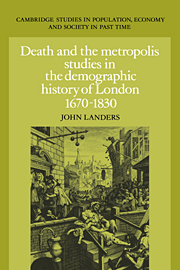Book contents
- Frontmatter
- Contents
- List of figures and maps
- List of tables
- Preface
- Acknowledgements
- Part I EIGHTEENTH-CENTURY LONDON AND ITS VITAL REGIME
- 1 Mortality theory and historical epidemiology
- 2 Aspects of metropolitan economic and social life
- 3 The ‘high potential’ model: a preliminary test
- Part II THE LEVEL OF MORTALITY
- Part III DIMENSIONS OF LONDON'S EPIDEMIOLOGICAL REGIME
- Appendices
- Bibliography
- Index
- Cambridge Studies in Population Economy and Society in Past Time
2 - Aspects of metropolitan economic and social life
Published online by Cambridge University Press: 05 November 2011
- Frontmatter
- Contents
- List of figures and maps
- List of tables
- Preface
- Acknowledgements
- Part I EIGHTEENTH-CENTURY LONDON AND ITS VITAL REGIME
- 1 Mortality theory and historical epidemiology
- 2 Aspects of metropolitan economic and social life
- 3 The ‘high potential’ model: a preliminary test
- Part II THE LEVEL OF MORTALITY
- Part III DIMENSIONS OF LONDON'S EPIDEMIOLOGICAL REGIME
- Appendices
- Bibliography
- Index
- Cambridge Studies in Population Economy and Society in Past Time
Summary
Classical mortality theory saw variations in living standards as the key to differences in the level of mortality. By implication at least, it was nutritionally determined resistance to infection which was the most important proximate determinant of mortality, and the socioeconomic component of a demographic regime could, in large measure, be summed up under the heading of diet, its quantity and composition. This orientation was maintained by neoclassical theory with its emphasis on real wages, since the latter were so powerfully determined by movements in food prices. By contrast, recent work in historical epidemiology – which we have tried to summarise in our theory of mortality potential – implies that a much broader range of social, economic and other variables, needs to be taken into account if the dimensions of an epidemiological regime are to be properly understood.
The proximate determinants on the ‘exposure side’ – conduction, retention and bounding – are affected by a wide variety of factors whose relative importance may vary between populations. Some – such as population density or migration patterns – fall outside the scope of ‘living standards’ as the term is generally understood, whilst others – such as hygiene, sanitation and housing standards – might usefully be thought of under this heading but are not easily captured in real wage calculations. In this chapter we shall look, in the broadest outlines, at the living conditions of London's population, so as to see how these might have affected the proximate determinants of mortality and the levels which the latter are likely to have assumed over our period.
- Type
- Chapter
- Information
- Death and the MetropolisStudies in the Demographic History of London, 1670–1830, pp. 40 - 88Publisher: Cambridge University PressPrint publication year: 1993



